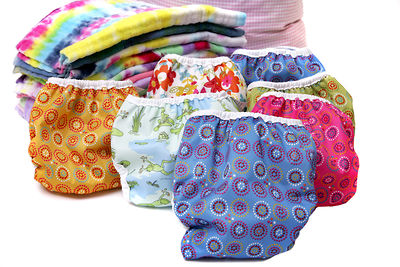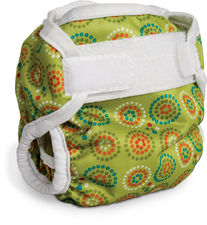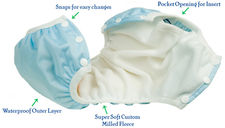Cloth Diapers – A Change for the Better!
What’s the poop about cloth vs. disposable?
Cloth diapers are making a big comeback. Modern parents place a premium on environmental sustainability, their newborn’s health, and the overall impact of the products they choose. The cloth diapers of today dismiss all the myths that keep people from using them. Cloth diapers are not only environmentally friendly, but they have the added bonus of being very economical. Don’t let the horror stories of being stuck doing loads and loads of laundry put you off. Today’s cloth diapers are easy to clean and convenient to use, over and over. Find out for yourself – cloth diapers may be the choice for you … and your retail customers!
Happy Heinys and Bummis offer a better bottom line.
Most parents feel the need to provide the very best that they can for their baby. In looking over the choices for diapering, a new parent must weigh the pros and cons of cloth vs. disposable diapers. One fact that makes cloth diapers so appealing is the lack of harmful chemicals. Diaper producers try to ensure that their cloth diapers are made without the use of bleach or other harmful toxins. Happy Heinys, a California-based manufacturer of made-in-U.S.A. cloth diapers, uses its own custom milled fleece to make a standard line of one-size pocket diapers. They also offer a line of hemp cloth diapers, giving parents the peace of mind that they are providing the best for baby.
Another equally appealing aspect of cloth diapers is the fact that users reduce trash, and reduce impact on the environment. Instead of tossing dozens of diapers a week into the landfill, washing and drying at home saves space. Happy Heinys makes a “one-size” line of diapers that can be used on babies from 7 lbs to 35 lbs, or as owner Linda Byerline says, “One diaper from birth to potty!” Considering the amount of disposable diapers that a baby goes through until potty training, this is a clear ecological advantage of cloth diapering.
Takes 2.5 times more water to make disposables!
Some argue that the washing and drying of cloth diapers makes them a less eco-friendly choice, but with today’s more efficient appliances and the use of line drying, cloth diaper users can relax, knowing that they have indeed made a good choice for the environment, as well as a healthy choice for their baby.
According to Linday Bylerline’s research,“ It takes 2.5 times more water to manufacture disposable diapers than it takes to wash reusable diapers. Reusable diapers also save on resources by using renewable resources. Cotton is a better choice for the environonment than the crude oils and tree pulp used to make disposable diapers.
Cotton up to savings of more than $2,000!
The cost of using cloth diapers also far outweighs the cost of using disposables. Linda Byerline reports, “It will cost roughly $450 to diaper a baby from birth to potty training vs. $2,500 for using disposable diapers that are purchased at big box wholesale stores. This cost goes up when one factors in emergency runs to the grocery stores.”
Dealing with dirty cloth diapers can seem to be a gross, time-consuming task. But with new, innovative designs, like Bummis’ flushable, biodegradable liners, dealing with diapers is no more of a hassle than dealing with a disposable diaper. No need to rinse and plunge the diapers in the toilet, trying to remove the solid waste. A parent just removes the liner, flushes it, and puts the diaper in the laundry basket. It is easy and convenient.
Another objection many parents have is the complexity of folding a square diaper and all of the pins and poking involved. Both Bummis and Happy Heinys have Velcro or snap fasteners, thus eliminating the hassle and headache that many parents experienced in the past. The user-friendliness of these diapers cannot be questioned, and more and more parents are choosing the convenience of cloth diapers.
Bummis and Happy Heinys produce diapers in a variety of colors and prints. These diapers can be handed down either to siblings or to other relatives and friends, extending their life and further reducing the amount of diapers that end up in the trash.
Cloth diapers have been with us for ages. Cloth diaper manufacturers have modernized the old cloth diaper and have made their products easily available, affordable, and convenient. Modern environmental concerns have tipped the scale in favor of the cloth diaper, updated and better than ever.
The Internet is awash in diapering discussions. There are many great Web sites dedicated to the cloth diaper and its proponents. www.Diaperjungle.com, www.clothdiapers.com, and www.realdiaperassociation.org are places to get further information on cloth diapering. There are many more cloth diaper manufacturers than those profiled in this article. Use the The Giggle Guide® as a starting point on your way to researching more companies who care about babies’ health and the environment.
Let us know what diapering products and accessories you think are number one … or number two! 














Comments
Good information
Thanks for the information about Cloth Diapers. I am expecting my first child and still undecided about using disposables vs. cloth. I want my baby and me to make a positive impact on the environment. I think there has to be a way to make it work too without breaking the bank. I plan to research more, but this definitely is getting me in the right direction.
~L